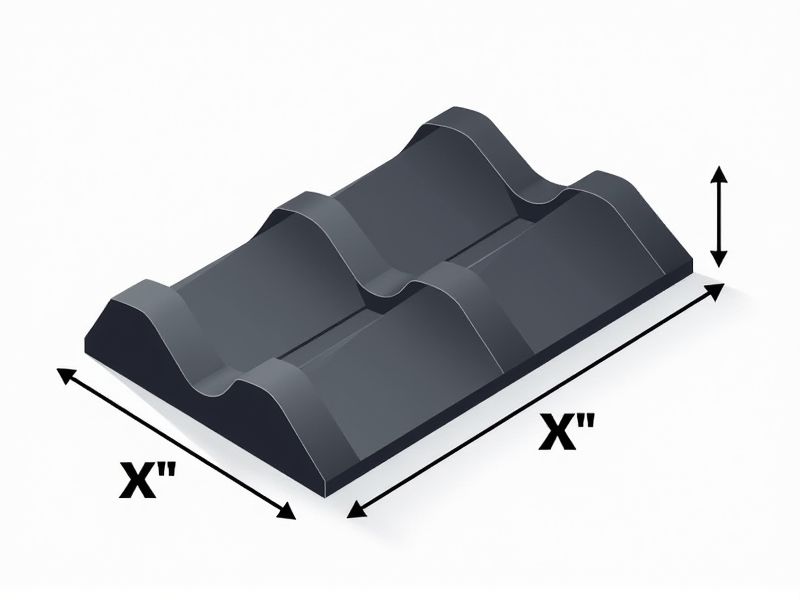
Asphalt shingles typically come in standard dimensions to facilitate easy installation and consistent coverage on roofs. The most common size for traditional 3-tab asphalt shingles is 12 inches wide by 36 inches long. These dimensions allow for effective overlapping, weather protection, and efficient handling during installation. Always refer to the manufacturer's guidelines, as some architectural or specialty shingles may have slightly different measurements for specific design or performance needs.
Length
The standard length of asphalt shingles typically ranges from 36 to 40 inches, providing substantial coverage for roofing projects. A standard three-tab asphalt shingle usually measures 36 inches long, while architectural shingles can reach lengths of 40 inches or more. This extended length helps in reducing the number of shingles required, potentially lowering material costs and installation time. Proper alignment and spacing of shingles are crucial to ensure effective weatherproofing and prevent leaks in your roofing system.
Width
Asphalt shingles typically come in a standard width of 39 inches, which allows for easier installation and uniformity across roofing projects. When selecting shingles, ensure they meet the ASTM D225 and ASTM D3462 specifications for quality and durability, important factors as they affect lifespan and performance. The exposure area, or the visible portion when installed, usually measures between 5 to 6 inches, impacting both aesthetics and weatherproofing. By choosing the right width and exposure, homeowners can enhance their roofs' efficiency and longevity.
Thickness
The thickness of asphalt shingles typically ranges from 1/4 inch to 1/2 inch, with premium options often exceeding this range for enhanced durability. Standard three-tab shingles are usually around 1/4 inch thick, while architectural shingles can measure up to 1/3 inch or more, offering better resistance to wind and weather. When choosing shingles, consider that thicker options may provide longer warranties, often between 25 to 50 years, depending on manufacturer specifications. Your energy efficiency can also improve, as thicker shingles can offer better insulation and protection against temperature fluctuations.
Exposure Size
The exposure size of asphalt shingles, typically ranging from 5 to 6 inches, significantly impacts the roofing system's appearance and performance. Standard exposure sizes influence water shedding and can affect the shingles' lifespan, often lasting between 20 to 30 years depending on quality. Selecting the appropriate exposure size is crucial for aesthetic compatibility and maximizing energy efficiency in your roof. Understanding these factors can lead to informed choices, ensuring a durable and visually appealing roof structure.
Bundle Coverage Area
The standard coverage area for a bundle of asphalt shingles typically ranges from 33 to 39 square feet, depending on the manufacturer and specific product line. Each bundle usually contains enough shingles to cover the equivalent of one-third of a square, where one square equals 100 square feet of roofing surface. It is essential to account for waste during installation, as this can add an extra 10-15% to your total material needs. Understanding these coverage metrics helps ensure you have the right amount of shingles for your roofing project, optimizing both cost and efficiency.
Weight Per Shingle
The standard weight of asphalt shingles typically ranges from 190 to 250 pounds per square, with a square being equal to 100 square feet of roofing area. Heavier shingles often offer increased durability and better resistance to wind, making them a popular choice for homeowners seeking long-term performance. Many high-quality asphalt shingles weigh around 265 pounds per square, offering enhanced warranty periods, often exceeding 30 years. When selecting shingles, consider that proper installation can significantly impact their overall effectiveness and longevity.
Bundle Weight
The standard weight of an asphalt shingle bundle typically ranges from 60 to 80 pounds, depending on the type and brand. This weight is crucial for assessing the durability and weather resistance of shingles during installation and after application. A standard roof requires approximately 3 to 4 bundles per square (100 square feet), translating to a total weight of 180 to 320 pounds per square. You're advised to consider bundle weight to ensure your roofing structure can adequately support the applied load.
Tab Count
Asphalt shingles typically come in various tab counts, which significantly influence their performance and aesthetics. The most common tab counts are three-tab and architectural shingles, with three-tab shingles featuring a uniform look and lower cost, while architectural shingles offer enhanced durability with their layered design. A standard three-tab shingle usually has dimensions of 36 inches by 12 inches, creating a coverage of approximately 33.3 square feet per bundle. When selecting shingles for your roofing project, consider the tab count to ensure optimal durability and visual appeal.
Overlap Allowance
The overlap allowance in asphalt shingles is a critical aspect that ensures effective weather resistance and longevity of your roof. Generally, a minimum overlap of 5 to 6 inches is recommended for proper installation, allowing for optimal water runoff and preventing leaks. This specification aligns with industry standards, contributing to the overall durability, with most asphalt shingles having a life expectancy of 20 to 30 years when installed correctly. When inspecting your roof, ensure that this overlap is consistently maintained across all shingle rows to safeguard against environmental elements.
Packaging Type
Packaging types for asphalt shingles typically include bundles, squares, and pallets. A standard bundle usually weighs between 60 to 80 pounds and contains about three to five shingles, covering approximately 33.3 square feet when installed. In contrast, a square consists of enough shingles to cover 100 square feet of roof area, enhancing convenience for larger projects. Ensuring your selected packaging meets local building codes and handling requirements is critical for a successful installation.
